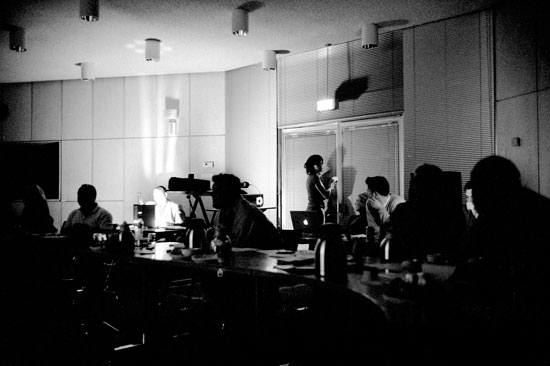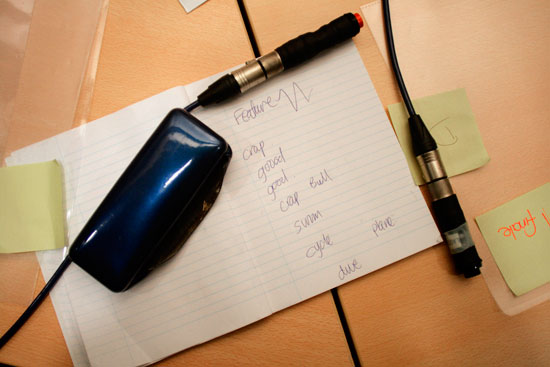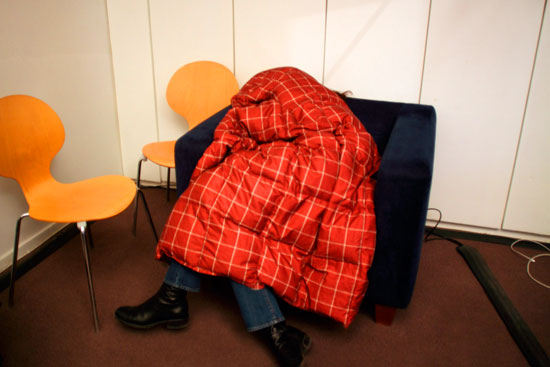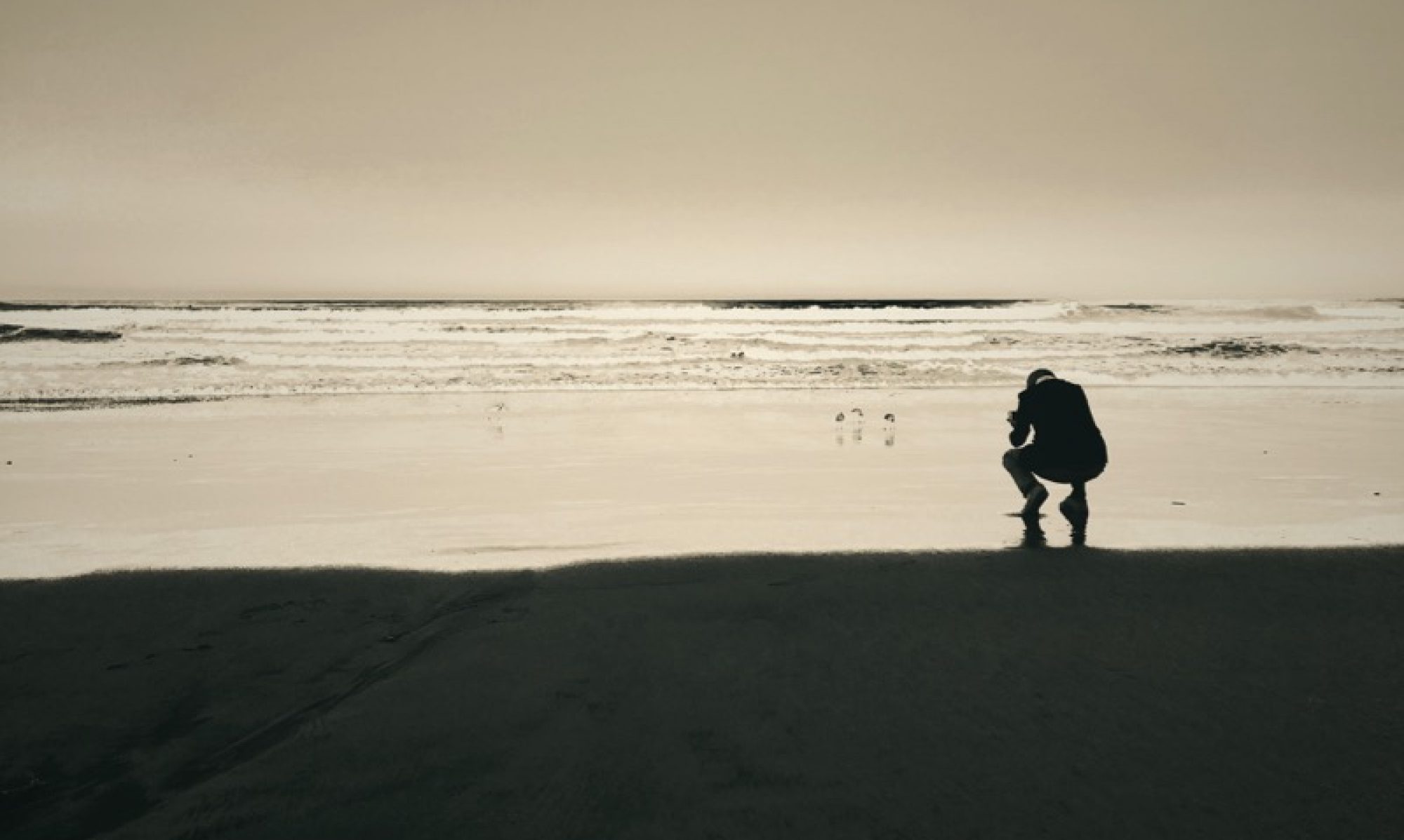Stephen Mayes, World Press Photo Secretary for six years, gave a widely noted keynote address at this year’s event in Amsterdam. Refreshing and fact driven, I think the address is relevant outside the field of photojournalism, as are his concerns that much of today’s photography emphasizes the romantic over the real, the copied view over the personal vision. If you have the time, I recommend to listen to the audio record of the whole thing, here. Excerpts from his original script, including three out of many photos Stephen took behind the scenes during his tenure, below. JH
[…] I wonder if World Press Photo is peeling away from reflecting the media as it is, and is rather reflecting the media the way we wish it were. Of the 376 images awarded prizes this year, I would be curious to know how many have been published in a paid-for context. Maybe all of them. Maybe. But the overall impression that I’m left with from the 470,214 images that I have seen entered into the contest in the current decade, is that they reflect a form of photojournalism that is now more romantic than functional.

[…] The overwhelming impression from the vast volume of images is that photojournalism (as a format for interpreting the world) is trying to be relevant by copying itself rather than by observing the world. Nowhere is this more obvious than at World Press Photo where every year the winners stimulate a slew of copyists (in style and content). It’s easy to understand why when we consider that the last twenty years has seen an explosion in the numbers of professional photojournalists and a collapse of the traditional markets. As more photographers compete for less page space, a lot of work ends up in competitions as the only outlet – and as the largest, World Press Photo gets more than its fair share.
Every year, the jury is astonished by the repetition of subjects and the lack of variety in the coverage. From the infinity of human experience the list of subjects covered by the entrants would fill a single page, and (excluding sports as a specialist area) could be reduced even to three lines:
– The disposed and the powerless
– The exotic
– Anywhere but home (the American election would be one of the exceptions to this rule….)

This is the general view, the blurred impression of 470,214 images and of course there are many exceptions. But meanwhile hospitals and the sick (and especially mental hospitals), the afflicted, the poor, the injured are photographed way in excess of their actual numbers. And I have a feeling that there are as many photographers as drug users in the Kabul’s Russian House. As one juror said this year, “90% of the pictures are about 10% of the world.”
– Over represented: commercial sex, suffering black folk, Muslim women in veils, same sex couples kissing, holding hands
– Under represented: middle class, affluent drug users, real sex, personal sex, black culture and expanded vision of black life outside Africa.
[…] What is journalism if it doesn’t inform but merely repeats and affirms what we already know?
– Part client-driven, which is the mirror on the media
– Part a phenomenon of the competition: pictures made for prizes
Interestingly, violence, which is perceived as the cornerstone of World Press Photo is not as heavily represented as people imagine: of the 376 award-winning images in 2009 only 25% [depict] violence/duress, and only 7% actual injury, blood and death.
Maybe the structure of the competition contributes a little to this process. As a category definition “Daily Life” implies a 20th century way of seeing that has been supplanted by “Lifestyle” in the 21st century. The connotations of this vocabulary are subtle but important: in general “Lifestyle” is considered to belong to people like us, and “Daily Life” is considered to belong to other people. But this in no way accounts for the dearth of imagination in how we as a profession represent the world.

[It is] important to take innovative risk as well as physical risk. Capa’s famous dictum that “if your pictures aren’t good enough, you’re not close enough” could be applied in this new context to describe an emotional closeness to ones subjects. By that I do not mean a sentimental display of warmth, but at least a real interest in the subject. The adherence to formulaic representation suggests a lack of connection with what’s truly meaningful to oneself and the impression is that many photojournalists photograph what they think they ought to photograph rather than what actually intrigues them.
[“Romantic, as in] heroic, adventurous, remote, mysterious or idealized” defines photojournalism as represented by the vast majority of the entries. Where is the intimate, the personal and the real?
More coverage of the event in Amsterdam here, further commentary here.

These comments are very much on point, however I think there is an overlooked connection here that might be interesting to tease out further: some of these under-represented realities mentioned above are not actually under-represented, just their representation is not considered journalism, but fine art. I find this puzzling, as if the representation of what I am going to call here the Art-School/B-School social class (middle class and beyond, white in the cultural if not in the biological sense, moneyed, leisured) is somehow not the same class of seeing/looking as to look at The Other, Victim, exotic class….which, of course, it IS….and the result is a kind of homogeneity and boredom in both image categories, a decay of relevance, an immunity.
As to the causes for this sameness, the source is not so much the image makers as the consumers, and I would argue not so much the consumers, who in a way have no direct agency, but the programmers. The game of image production is a little like musical chairs on a spinning carousel, and believe me, we photographers don’t pick the ponies, we just try desperately to hop on them…
This is the second year in a row that a World Press Photo decision-maker has made comments about the current state of photojournalism, and Stephen does an excellent job at articulating the core issue in a concise way: “But the overall impression that I’m left with from the 470,214 images that I have seen entered into the contest in the current decade, is that they reflect a form of photojournalism that is now more romantic than functional.”
Last year, Adam Broomberg and Oliver Chanarin wrote an insightful piece about their experience and observations while judging the World Press Photo competition. They, too, highlighted the issue that photojournalism is facing. In summary, relevance and impact.
What is the true motivation of a photojournalist today? Do they really want to “make a difference” or is the role still seen as a glamorous, fanciful, money earner that affords an individual the opportunity to go to exotic and extreme locations on paid assignment? The latter option is increasingly rare. The money-earning aspect is highly questionable, and if the top prize winner of this year’s WPP competition was out of work at the time of the award, what does this tell us?
After seeing thousands of grainy, black and white images of starving children, why should another photograph of the same subject make a difference?
Sadly, the public has become desensitized to much of what is going on in the world. It is more difficult to shock people in to taking action. And with the internet as an increasingly popular choice for news delivery, we can be selective about what news we see, getting to a point where we can be completely unaware of critical humanitarian problems in all parts of the world (even in the USA).
Photojournalism IS seeing some changes: a growing number of photojournalists are migrating to video and multimedia, for example. But a revenue model that can sustain photojournalism as an industry, and photojournalism as a career, still seems to be a long way off.
This may be news to Stephen and WPP, but many in the photo world reached these and many other conclusions a long time ago [edited for NYPH’09 promotional content, of which Frank is a co-chair and co-founder; the website of the NYPH is here; a list of reviews of the ’09 event here – JH] When Stephen says “Where is the intimate, the personal and the real?”, I say, “right in front and all around you. Where have you been?”
I delight in the exceptional contributions of many documentary photographers exploring new frontiers but my comments reflect the overwhelming impression of seeing half a million images submitted to the World Press photo competition. The World Press Photo offers an unflinching reflection on the contemporary media which many might find uncomfortable.
Well, I guess Stephen is 50% right. But is it only the limited “imagination” of the photographers or does this apply also to photo editors!?
When looking at many publications, the things that get published or are wanted by the editors are very often very similar. So, if you want to get published, [if you want to] make some money, you have to jump on the bandwagon I suppose.
Sure, if you are not taking pictures for a living, then I assume it is easier to invest the huge amount of time to cover an issue, to create the kind of intimacy the judges seem to miss. But otherwhise it turns out to be a spare time project and therefore again is not the “reality” of photojournalism.
Um, regardless of whether or not the judges thought there were too many entries that fell under the same themes (actually, real journalism themes if we have to define them), I doubt any one of the judges can actually justify some of their more ridiculous choices. It seems that we have totally given up on journalism when pictures of toy soldiers are chosen as winners and even defined as real journalism. Bullshit, is what I say it is. And it seems like an even larger steaming pile to suggest that photojournalists should not focus on the plight of the under-privileged. Ridiculous talk. We might as well all get out or Legos for next years competition.
With all due respect to everything said here, WPP needs to keep it’s mouth tightly shut after the disgrace of the last two years.
Why do we even go anywhere, risk our lives and spend all this money to capture that “reality” he talks about when at the end of it, they award posed pictures of toy soldiers representing famous photos?
He’s talking about copyist? It’s WPP who created the kind, photographers understood a few years back that WPP doesn’t award excellence in photojournalism, but rather satisfy the ego of the judges by choosing “something different” so THEY can be remembered. So young photographers try to follow those last wins in hope to get chosen for having photographed something that fits into the twisted judge’s mind.
How about standing behind your words and choosing only newspaper and magazine editors as judges, and actually rewarding the “real” photojournalism.
Your responsibility as a photo industry leader is to educate, but it’s too easy to slam the photographers, there have always been crappy photographers and there always will be, WPP is the only one who publishes them. Let’s see you open your mouth this wide about the editors. Let’s see you make a change and help the industry.
Last thing, as soon as any newspaper or magazine will publish those other 90% of stories, we’ll all be out there taking those photos, it’s hard enough to get the 10% sold these days.
Why do you think “The disposed and the powerless, – The exotic, and – Anywhere but home” are odd categories for popularity? These are the items people want to learn about. Their everyday lives they already know.
I think I am more inclined to agree with Stephen Mayes on this:
“The overwhelming impression from the vast volume of images is that photojournalism (as a format for interpreting the world) is trying to be relevant by copying itself rather than by observing the world.”
As a sometime editor (always a shooter as well) I am seeing a lot of “great photographs” that have no relation to reality… I see this especially in the new breed of “war photographers,” and I use that term loosely, who have imitated the style of Gilles Peress and others. This abstracted work […] bears little relationship to what they are photographing. This is most often seen in embeds where there is clearly nothing happening, yet the photographer comes back with blurred juxtapositions of heads, strange compositions that are really about waiting for something to happen… “great” photographs that are stylistically derivative and really dishonest.
The harder work of digging for a deeper meaning, or bringing an understanding to the viewer and letting the truth just emerge, is not accomplished. Instead the photographer shoots abstract compositions, often because the photographer is there on a one week trip and has absolutely no idea what is really happening. Just to show you an example I refer you here, Ricardo Garcia Vilanova, which is a really extreme case of this. These are all pictures of pictures, visual cliches of blurs, looking through mirrors, reflections, etc. never really dignifying anybody as a human being. I would suggest that this is exactly the kind of work presented at World Press.
The world is an amazing place… do the hard work and find images that one can look at and say “wow, that really happened” as in for example the picture of the mountain gorilla being carried off after its death. Did this photographer have to stick a 50mm lens up someone’s nose to create a great “photograph?” Not at all, because there actually was some content which had significance. Going even further, because of the prevalence of image manipulation in Photoshop, the kind of obfuscation that Gilles achieved strictly with camera and lens, is all over the place now, but achieved in post-production. Viewers have trouble believing anything. So where in 1984 Peress was radical, in 2009 it is exactly the opposite, its now the norm. Not easy to do, but a cliche nevertheless.
Please allow me a link to 100eyes Magazine where I think you will see photographers who have gone a bit farther in understanding their subjects than many. This month’s issue is on prison in America.
Whenever I enter a place where there is a photojournalism exhibit, I usually spy the floor to see if I see any socks that have been knocked off. Lately I haven’t found any socks.
The three words “World” “Press” and “Photo” describe the parameters of the competition, and those who pay attention to the press will be aware that hard news is only a small aspect of the business. Li Jiejun’s pictures of toy soldiers do not pretend to be reportage but they have a valid place in the contemporary media, for which they were awarded a prize. The 2009 jury comprised a majority of magazine and newspaper editors and their choices offer a true reflection of today’s media, however uncomfortable many find it. As professional messengers we should all be careful about who we choose to shoot… Notes From Nowhere published a small excerpt from my presentation about World Press Photo which includes a more rounded review of the industry, including the role of the picture-buyers in shaping the pattern of today’s photographic output. You can hear the full speech here.
A note from the publisher on what follows below: Please keep it civil. Using a phony name and a fake email account will likely make me block an otherwise interesting opinion. The same goes for the use of strong language, or ad hominem abusives. A combination of these three is almost always a waste of time.
So, what follows are two comments that I would normally be inclined to block. You decide. JH
Stephen,
Saying “they have a valid place in the contemporary media” is somewhere between a bad joke and a plain spit in the face to the people who pay your salary and to all the people who inspired you to enter this profession.
There is room for toy soldiers, absolutely, in a pop art gallery. I’d even buy one myself to give someone as a joke. (maybe to the Capa foundation) Not in the press, (it has never been published in a newspaper or mainstream magazine as far as i know) and all those judges would never actually publish most of this (or last) year’s choices in their own magazines. it’s easy to see, the vast majority of last year’s choices never made it the main-stream media, and i doubt any of this year’s will. So World Press Photo, has little to do with the World (toy soldiers mimicking famous photos) and almost nothing to do with the Press this year.
You attack the photojournalists, for trying to abide to the travesty that is WPP to photojournalists, a freak show that you had a large hand in creating (look at the years that preceded you). Young photographers submit the crap that they do because that’s what you award, year after year.
When judges knowingly chose photos they themselves would never print, it says something about ego…
Not once did i hear you say anything in public about the editors or the wires killing our profession. Never did i hear you go out against the photographers that work with you when they give away their work for free (or almost free) thus putting another nail in the coffin of our younger generation.
And don’t get me started on the role your former employer (Getty) has in destroying what’s left of photojournalism.
How many of these awarded photos where pre-commissioned assignments? How many of these photographers make a decent living from their chosen profession?
Where are the voices of our time? The one time you have a public stage to the world of editors and publishers you turn around, (not that you don’t have their ear any day of the week) you turn around and shoot your poison at us. another nail in the coffin, like we needed that.
I had a lot of respect for you, you said you went to stock in order to come back and learn how to make money from photojournalism, i’m sure you’re pockets are full now, (ours are empty) but you forgot about responsibility towards your peers. I expected you to stand for us, not against us.
It’s time to give back, to use your power and status to show that you can make a positive change in our industry.
“The 2009 jury comprised a majority of magazine and newspaper editors and their choices offer a true reflection of today’s media, however uncomfortable many find it.”
Eh, no one’s swallowing that bullshit this year, man. Can we please have some of these people banned from further participation as judges in the future?
And shouldn’t there be an artsy-fartsy contest somewhere with a ‘Still Life’ category in which Li Jie Jun’s toy soldiers could be entered? Regardless of whether or not they have a place in today’s media, I doubt it is in the category of Portraits, the category in which they placed 3rd. Is it even POSSIBLE to have a portrait of a non-living object??